Burn Restrictions
CURRENT FIRE DANGER

Understanding Fire Danger Levels and Restrictions
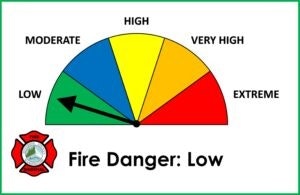
When the fire danger is LOW, fuels do not ignite easily from small embers, but a more intense heat source, such as lightning may start fires in duff or dry rotten wood. Fires in open, dry grasslands may burn easily a few hours after a rain, but most wood fires will spread slowly, creeping or smoldering. Control of fires is generally easy.
Prohibited:
- No restrictions
Allowed:
- Recreational wood fires
- Yard debris or land clearing burning
- Gas or propane fueled appliances, BBQs
- Open flame devices such as tiki torches
- Liquid fuel candles, lanterns.
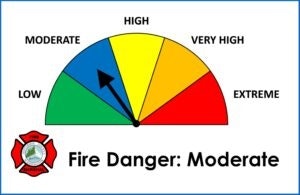
When the fire danger is MODERATE, fires can start from most accidental causes, but the number of fire starts is usually pretty low. If a fire does start in an open, dry grassland, it will burn and spread quickly on windy days. Most wood fires will spread slowly to moderately. Average fire intensity will be moderate except in heavy concentrations of fuel, which may burn hot. Fires are still not likely to become serious and are often easy to control.
Prohibited:
- No land clearing or yard debris burning
- No gas or propane weed burners
Allowed:
- Recreational wood fires
- Gas or propane fueled appliances, charcoal BBQs
- Open flame devices such as tiki torches
- Liquid fuel candles, or lanterns
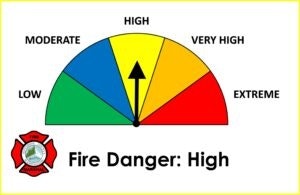
When the fire danger is HIGH, fires can start easily from most causes and small fuels (such as grasses and needles) will ignite readily. Unattended campfires and brush fires are likely to escape. Fires will spread easily, with some areas of high-intensity burning on slopes or concentrated fuels. Fires can become serious and difficult to control unless they are put out while they are still small.
Prohibited:
- Recreational wood fires
- Wood or charcoal cooking
- Yard debris or land clearing burning
- Open flame devices such as tiki torches, liquid fuel candles, or lanterns
- Gas or propane fired weed burners
- Discharge of fireworks of any type
- Firearms discharge on unimproved county lands
- Exploding targets, incendiary ammunition
Allowed:
- Gas or propane fueled appliances
- Wood or solid fuel enclosed flame cooking
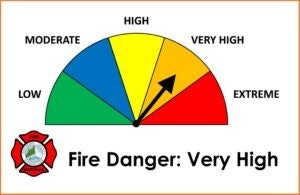
When the fire danger is VERY HIGH, fires will start easily from most causes. The fires will spread rapidly and have a quick increase in intensity, right after ignition. Small fires can quickly become large fires and exhibit extreme fire intensity, such as long-distance spotting and fire whirls. These fires can be difficult to control and will often become much larger and longer-lasting fires.
Prohibited:
- Recreational wood fires
- Wood or charcoal cooking
- Yard debris or land clearing burning
- Open flame devices such as tiki torches, liquid fuel candles, or lanterns
- Gas or propane fired weed burners
- Discharge of fireworks of any type
- Firearms discharge of any kind
Allowed:
- UL listed enclosed flame gas, propane or wood pellet fueled appliances only
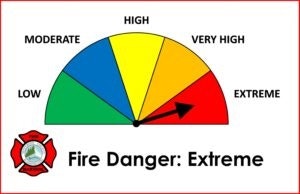
When the fire danger is EXTREME, fires of all types start quickly and burn intensely. All fires are potentially serious and can spread very quickly with intense burning. Small fires become big fires much faster than at the VERY HIGH level. Spot fires are probable, with long-distance spotting likely. These fires are very difficult to fight and may become very dangerous and often last for several days.
Prohibited:
- All outdoor fires, burning, or discharge of any kind or type
Allowed:
- No allowed devices, full ban on ANY fire or burning related activity
If you have questions about devices or activities not listed please contact the County Fire Marshal's Office at 360-379-4450 or the Fire District at 360-765-3333.
Outdoor Burning Fact Sheet.pdf2024 BURN PERMIT - Fill Online.pdf
